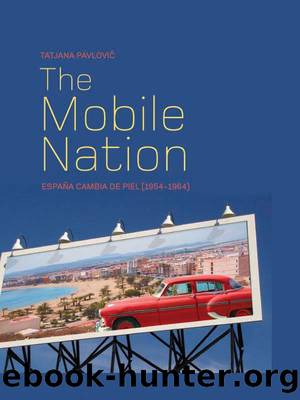The Mobile Nation by Pavlovic Tatjana

Author:Pavlovic Tatjana [Tatjana, Pavlovic]
Language: eng
Format: epub
Tags: Performing Arts, Film, General
ISBN: 9781841503240
Google: U2qC9kR42psC
Publisher: Intellect Books
Published: 2011-01-15T05:36:12+00:00
CHAPTER III
Voces de oro: Spain, modernity, and the child-star system
After panning valleys, rivers and mountains the camera focuses on a remote village, zooming in on a lonely figure walking down empty, cobblestone streets. The scene is accompanied by sacred polyphony reminiscent of Palestrina.1 The figure is that of a woman carrying a suitcase. Her modern style is incongruously at odds with the rural surroundings. She continues her descent until a church bell-tower comes into view. At this moment, the streets are suddenly filled with an eerily magical voice singing the Ave MarÃa. The woman is enthralled and the overpowering Ave MarÃa also sweeps up the audience. As if out of nowhere the voice is heard offscreen, and no specific source can be attributed to the sound.2 A few moments later, however, the voice becomes attached to a body. Somewhat surprisingly, the penetrating voice is that of a small boy in the church tower. His petite stature is accentuated by his posture: he is teetering on a chair and can barely reach the bell that he is tolling.
The boy-soprano is José Jiménez Fernández in the 1956 film El pequeño ruiseñor. This was his début on the silver screen. He would become known as Joselito (el pequeño ruiseñor or little nightingale) and from that moment forward his real-life persona would become inseparably blurred with his screen persona. His diagetic success likewise transcends the confines of the frame, becoming an object of endearment first in rural Spain, then in the Spanish capital, Madrid, and finally being reinvented as an export throughout Latin America.
The second Spanish junior to achieve child stardom would be Josefa Flores, known to her public as Marisol. Her first appearance was in Un rayo de luz in 1960. Like Joselito, Marisol first startled the audience through song. In a well-appointed salon in an Italian country villa, Marisol sings the popular Italian classic Santa Lucia. Suddenly, she switches from the melody and atavistically turns to her ânativeâ flamenco. The reaction of the governess and her paternal grandfather is one of horror and condescending disapproval.
To the Spanish public of the 1960s Joselito and Marisol would be inescapably associated with childrenâs cinema (a Shirley Temple cinema). What distinguishes them from their under-age predecessors is that Joselito and Marisol would be subjected to the making-of-a-star system. Such a system demanded exclusive contracts, the morphing of personal life with their star personae, as well as the multiple marketing ploys aimed at promoting their image, such as fan clubs, franchises, merchandise endorsements and carefully scheduled âimpromptuâ appearances.
Because of Joselitoâs and Marisolâs success, modern audiences can easily forget that there were many child actors that came before. To mention a couple, there were Alexia Ventura and Alfredo Hurtado. To quote Carlos Heredero:
In 1915 Hispano Films (la productora catalana) intenta hacer de Alexia Ventura el epÃgono local de Mary Pickford y en la década siguiente es Alfredo Hurtado, alias âPitusÃn,â quien se convierte en el primer âniño prodigioâ del cine español desde la temprana edad de los cuatro años y deviene luego el equivalente de Jackie Coogan.
Download
This site does not store any files on its server. We only index and link to content provided by other sites. Please contact the content providers to delete copyright contents if any and email us, we'll remove relevant links or contents immediately.
Room 212 by Kate Stewart(4125)
The Crown by Robert Lacey(4122)
Endurance: Shackleton's Incredible Voyage by Alfred Lansing(3862)
The Iron Duke by The Iron Duke(3659)
The Rape of Nanking by Iris Chang(3535)
Killing England by Bill O'Reilly(3469)
Joan of Arc by Mary Gordon(3275)
Say Nothing by Patrick Radden Keefe(3078)
I'll Give You the Sun by Jandy Nelson(2850)
Shadow of Night by Deborah Harkness(2749)
Hitler's Monsters by Eric Kurlander(2741)
Margaret Thatcher: The Autobiography by Thatcher Margaret(2692)
Mary, Queen of Scots, and the Murder of Lord Darnley by Alison Weir(2683)
Darkest Hour by Anthony McCarten(2656)
Blood and Sand by Alex Von Tunzelmann(2617)
Red Famine: Stalin's War on Ukraine by Anne Applebaum(2473)
Eleanor & Park by Rainbow Rowell(2402)
The One Memory of Flora Banks by Emily Barr(2358)
Book of Life by Deborah Harkness(2286)
